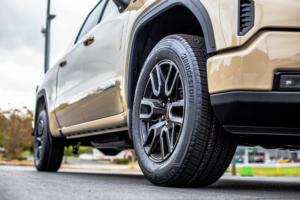Upgrade your truck’s performance and handling with a set of new tires. Our selection of truck tires is sure to have the perfect set for your needs, whether you’re looking for on-road performance or off-road capability. New tires can improve your truck’s performance by providing better grip, handling, and acceleration. They can also improve your truck’s safety by providing better traction in wet and snowy conditions. Additionally, new tires can extend the tread life of your tires, saving you money in the long run.
Tire Construction
The construction of a tire can affect its durability, performance, and noise levels. For example, a tire with a radial construction is typically more durable and performs better than a tire with a bias-ply construction. Radial tires are constructed with steel belts that are oriented at a 90-degree angle to the tread. This allows the sidewall and tread to function as two independent features of the tire. Radial tires are typically more durable and perform better than bias-ply tires because they can handle higher loads and speeds. They also have lower rolling resistance, which can improve fuel economy. Bias-ply tires are constructed with cords that are oriented at a 30- to 45-degree angle to the tread. This makes the sidewall and tread interdependent, which can make the tire more flexible and comfortable. Bias-ply tires are typically less expensive than radial tires, but they are not as durable or as fuel-efficient.
Tire Size
The best size of tires for your truck will depend on the type of driving you do most often and your personal preferences. If you do a lot of highway driving, you may want to choose larger tires for improved handling and traction. If you do a lot of off-road driving, you may want to choose smaller tires for improved fuel economy and acceleration. It is also important to consider the weight of your truck when choosing tire size. If your truck is heavy, you will need larger tires to support the weight. If your truck is light, you may be able to get away with smaller tires. No matter what size tires you choose, be sure to check the manufacturer’s recommendations to make sure you are getting the right tires for your truck.
Tread Pattern
The type of tread pattern you need will depend on the type of driving you do most often and the conditions you will be driving in. Symmetrical tread patterns are the most common type of tread pattern. They are designed for all-season use and provide good traction in a variety of conditions. Asymmetric tread patterns are designed for specific driving conditions. For example, an asymmetric tread pattern with large tread blocks on the outside of the tire and smaller tread blocks on the inside of the tire is designed for off-road use. Directional tread patterns are designed to move water away from the tire’s contact patch. They are best suited for wet and snowy conditions. No matter what type of tread pattern you choose, be sure to check the manufacturer’s recommendations to make sure you are getting the right tires for your truck.











